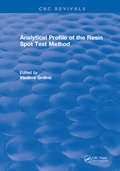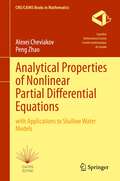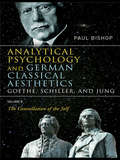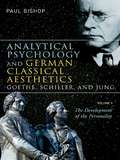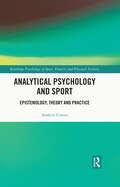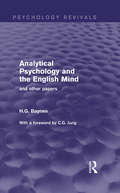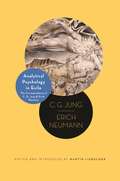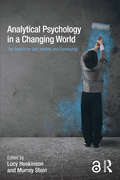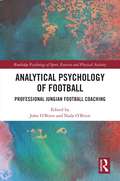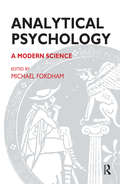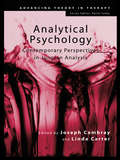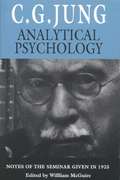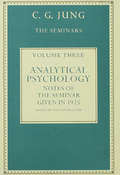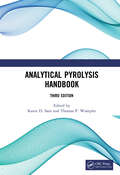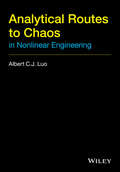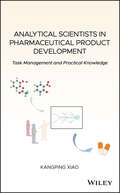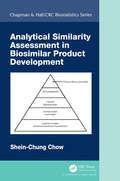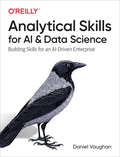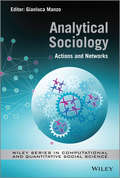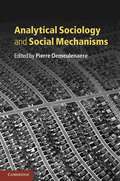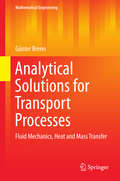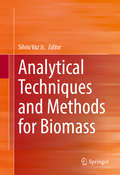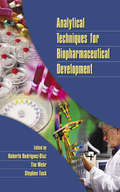- Table View
- List View
Analytical Profile of the Resin Spot Test Method
by Vladimir GrdinicThe working title of the book was The Detection of Analytes by the Resin Spot Tests Method. Firstly, we decided to sort out all published qualitative methods systematically against analytes. We were not discouraged by the obstacles, such as the study of a great number of papers published in Japanese, the difficulty in locating (especially older) publications, or the time required. Still, having in mind not to burden unnecessarily the volume of the book, we dismissed the idea of systematically listing all the procedures in detail. Nevertheless, a relatively large number of them found a place in the book, and perhaps this will contribute to the stirring of spontaneous interest in this technique in the ranks of applied chemists and others who a priori shun the technique.
Analytical Properties of Nonlinear Partial Differential Equations: with Applications to Shallow Water Models (CMS/CAIMS Books in Mathematics #10)
by Alexei Cheviakov Shanghai Maritime UniversityNonlinear partial differential equations (PDE) are at the core of mathematical modeling. In the past decades and recent years, multiple analytical methods to study various aspects of the mathematical structure of nonlinear PDEs have been developed. Those aspects include C- and S-integrability, Lagrangian and Hamiltonian formulations, equivalence transformations, local and nonlocal symmetries, conservation laws, and more. Modern computational approaches and symbolic software can be employed to systematically derive and use such properties, and where possible, construct exact and approximate solutions of nonlinear equations. This book contains a consistent overview of multiple properties of nonlinear PDEs, their relations, computation algorithms, and a uniformly presented set of examples of application of these methods to specific PDEs. Examples include both well known nonlinear PDEs and less famous systems that arise in the context of shallow water waves and far beyond. The book will beof interest to researchers and graduate students in applied mathematics, physics, and engineering, and can be used as a basis for research, study, reference, and applications.
Analytical Psychology and German Classical Aesthetics: The Constellation of the Self
by Paul BishopThe second volume of Analytical Psychology and German Classical Aesthetics builds on the previous volume to show how German classicism, specifically the classical aesthetics associated with Goethe and Schiller known as Weimar classicism, was a major influence on psychoanalysis and analytical psychology alike. This volume examines such significant parallels between analytical psychology and Weimar classicism as the methodological similarities between Goethe’s morphological and Jung’s archetypal approaches, which both seek to use synthesis as well as analysis in their attempt to understand the world. It also focuses on the project of the construction of the self, which, it is argued, is not only a personal but also a cultural activity. This book, like its previous volume, aims to clarify the intellectual continuity between Weimar classicism and analytical psychology. It will be of interest to both students and scholars in the fields of analytical psychology, comparative literature, and the history of ideas.
Analytical Psychology and German Classical Aesthetics: The Development of the Personality
by Paul BishopIn this volume, Paul Bishop investigates the extent to which analytical psychology draws on concepts found in German classical aesthetics. It aims to place analytical psychology in the German-speaking tradition of Goethe and Schiller, with which Jung was well acquainted. Analytical Psychology and German Classical Aesthetics argues that analytical psychology appropriates many of its central notions from German classical aesthetics, and that, when seen in its intellectual historical context, the true originality of analytical psychology lies in its reformulation of key tenets of German classicism. Although the importance for Jung of German thought in general, and of Goethe and Schiller in particular, has frequently been acknowledged, until now it has never been examined in any detailed or systematic way. Through an analysis of Jung’s reception of Goethe and Schiller, Analytical Psychology and German Classical Aesthetics demonstrates the intellectual continuity within analytical psychology and the filiation of ideas from German classical aesthetics to Jungian thought. In this way it suggests that a rereading of analytical psychology in the light of German classical aesthetics offers an intellectually coherent understanding of analytical psychology. By uncovering the philosophical sources of analytical psychology, this first volume returns Jung’s thought to its core intellectual tradition, in the light of which analytical psychology gains new critical impact and fresh relevance for modern thought. Written in a scholarly yet accessible style, this book will interest students and scholars alike in the areas of analytical psychology, comparative literature, and the history of ideas.
Analytical Psychology and Sport: Epistemology, Theory and Practice (Routledge Psychology of Sport, Exercise and Physical Activity)
by Andrew CowenAnalytical Psychology and Sport: Epistemology, Theory and Practice introduces the epistemology and psychology of C.G. Jung to the sport psychology readership. In doing so, it considers for the first time the implications of analytical psychology with respect to theorising on well-established psychological phenomena in sport, including confidence, mental toughness and psychological momentum. To date, sport psychology has given limited consideration to how epistemology itself informs the development of knowledge. In light of Jung’s epistemological contributions and more recent developments in psychology, this new book explores how a renewed focus on the philosophy of science can help facilitate the development of sport psychology as a scientific discipline. This new research volume investigates analytical psychology in relation to a number of novel topics, including person–athlete interdependence and the psychology of performance variation, and will be key reading for academics and students of sport and exercise psychology, analytical psychology and related disciplines.
Analytical Psychology and the English Mind: And Other Papers (Psychology Revivals)
by H.G. BaynesOriginally published in 1950, the name of the late Dr H.G. Baynes was already well-known as a leading exponent of and translator of the writings of Professor C.G. Jung, as author and as psychotherapist. The essay which gives it title to this varied and interesting collection of writings, shows clearly Dr Baynes’s gift for illuminating a familiar subject with fresh insight drawn from his wide knowledge of the unconscious mind. He can make the unconscious real to us, and can convince us that myth and dream are expressions of vital problems of the human soul. The collection includes material to interest many types of reader, from The British Journal of Medical Psychology, from Folk-Lore, from The Society for Psychical Research. But perhaps most full of interest for the majority of readers are the first three chapters of an unfinished book – What It Is All About; here we find an admirable introduction, given with a wealth of illustration, to the main concepts of Professor Jung’s analytical psychology. Dr Baynes made Professor Jung’s thought his own, without loss of his own originality. He can touch with significance any subject on which he writes, whether it be the problem of the individual or the kindred problems of humanity.
Analytical Psychology in Exile: The Correspondence of C. G. Jung and Erich Neumann (Philemon Foundation Series)
by Erich Neumann C. G. JungTwo giants of twentieth-century psychology in dialogueC. G. Jung and Erich Neumann first met in 1933, at a seminar Jung was conducting in Berlin. Jung was fifty-seven years old and internationally acclaimed for his own brand of psychotherapy. Neumann, twenty-eight, had just finished his studies in medicine. The two men struck up a correspondence that would continue until Neumann's death in 1960. A lifelong Zionist, Neumann fled Nazi Germany with his family and settled in Palestine in 1934, where he would become the founding father of analytical psychology in the future state of Israel.Presented here in English for the first time are letters that provide a rare look at the development of Jung&’s psychological theories from the 1930s onward as well as the emerging self-confidence of another towering twentieth-century intellectual who was often described as Jung&’s most talented student. Neumann was one of the few correspondence partners of Jung&’s who was able to challenge him intellectually and personally. These letters shed light on not only Jung&’s political attitude toward Nazi Germany, his alleged anti-Semitism, and his psychological theory of fascism, but also his understanding of Jewish psychology and mysticism. They affirm Neumann&’s importance as a leading psychologist of his time and paint a fascinating picture of the psychological impact of immigration on the German Jewish intellectuals who settled in Palestine and helped to create the state of Israel.Featuring Martin Liebscher&’s authoritative introduction and annotations, this volume documents one of the most important intellectual relationships in the history of analytical psychology.
Analytical Psychology in a Changing World: The Search For Self, Identity And Community
by Murray Stein Lucy HuskinsonHow can we make sense of ourselves within a world of change? In Analytical Psychology in a Changing World, an international range of contributors examine some of the common pitfalls, challenges and rewards that we encounter in our efforts to carve out identities of a personal or collective nature, and question the extent to which analytical psychology as a school of thought and therapeutic approach must also adapt to meet our changing needs. The contributors assess contemporary concerns about our sense of who we are and where we are going, some in light of recent social and natural disasters and changes to our social climates, others by revisiting existential concerns and philosophical responses to our human situation in order to assess their validity for today. How we use our urban environments and its structures to make sense of our pathologies and shortcomings; the relevance of images and the dynamic forms that underpin our experience of the world; how analytical psychology can effectively manage issues and problems of cultural, religious and existential identity – these broad themes, and others besides, are vividly illustrated by striking case-studies and unique personal insights that give real lucidity to the ideas and arguments presented. Analytical Psychology in a Changing World will be essential reading for Jungian and post-Jungian scholars and clinicians of depth psychology, as well as sociologists, philosophers and any reader with a critical interest in the important cultural ideas of our time.
Analytical Psychology of Football: Professional Jungian Football Coaching (Routledge Psychology of Sport, Exercise and Physical Activity)
by Nada O’Brien John O’BrienJungian psychology of football is a new and cutting edge approach being applied by Champions league teams and used in youth football training. Implications for the wider role of football organisations in society as models for the diagnosis and management of trauma and tension in our changing world are highlighted. Analytical Psycholog y of Football: Professional Jungian Football Coaching provides for youth trainers, accessible, scientifically based tools and techniques to develop resilience and sustain motivation in grass roots and elite footballers. The values and psychological make-up of best in class international trainers are revealed, and commented upon by a Champions League manager. Theory is traced from the early history of the game through to the present day, equipping trainers with the guiding psychological concepts which are shaping the future of the sport. Case examples of how the game can support society through periods of change, and in fact, advance civilisation are described. A Jungian appreciation of the transformational power of the football is a step forward for psychologists, and educators who wish to keep up with advancements in their professions, for football students and for trainers wishing to remain competitive.
Analytical Psychology: A Modern Science (The\library Of Analytical Psychology Ser.)
by Michael FordhamThis is a book of two parts: the first focuses on theoretical concepts with special reference to the structure of the psyche, while the second includes more clinical material. Both exemplify the London Society's interest in childhood and the development of ideas about the use of reductive analysis within the Jungian framework.
Analytical Psychology: Contemporary Perspectives in Jungian Analysis (Advancing Theory in Therapy)
by Joseph Cambray Linda CarterThe Jungian approach to analysis and psychotherapy has been undergoing an extensive reconsideration during the past decade. Analytical Psychology calls special attention to the areas that have been most impacted: the core concepts and practices of the Jungian tradition, along with relevant intellectual and historical background.Internationally renowned authors drawing on the forefront of advance in neuroscience, evolution, psychoanalysis, and philosophical and historical studies, provide an overview of the most important aspects of these developments. Beginning with a chronicle of the history of the Jungian movement, areas covered include:* a background to the notion of 'archetype'* human development from a Jungian perspective* the creative extension of Jung's theory of psychological types* re-evaluation of traditional Jungian methods of treatment in the light of contemporary scientific findings* Jungian development of transference and countertransference* a new formulation of synchronicity. Analytical Psychology presents a unique opportunity to witness a school of psychotherapy going through a renaissance. Drawing on original insights from its founder, C.G. Jung, this book helps focus and shape the current state of analytical psychology and point to areas for future exploration.
Analytical Psychology: Its Theory and Practice (Routledge Classics)
by Carl Gustav JungIn 1935 Jung gave a now famous and controversial course of five lectures at the Tavistock Clinic in London. In them he presents, in lucid and compelling fashion, his theory of the mind and the methods he had used to arrive at his conclusions: dream analysis, word association and ‘active imagination.’ Immediately accessible to the general reader, the Tavistock lectures are a superb introduction to anyone coming to Jung’s psychology for the first time and crucial for understanding analytical psychology. A fascinating feature of the book is the inclusion of some of the questions posed to Jung at the end of each lecture. These questions, including those from leading psychoanalysts such as Wilfrid Bion, and the discussions that follow offer an outstanding example of a great thinker at the peak of their powers. Also amongst the audience was Samuel Beckett, who was deeply affected by what Jung had to say.With a new foreword by Kevin Lu
Analytical Psychology: Notes of the Seminar Given in 1925 (Jung Seminars #601)
by C. G. JungFor C. G. Jung, 1925 was a watershed year. He turned fifty, visited the Pueblo Indians of New Mexico and the tribesmen of East Africa, published his first book on the principles of analytical psychology meant for the lay public, and gave the first of his formal seminars in English. The seminar, conducted in weekly meetings during the spring and summer, began with a notably personal account of the development of his thinking from 1896 up to his break with Freud in 1912. It moved on to discussions of the basic tenets of analytical psychology--the collective unconscious, typology, the archetypes, and the anima/animus theory. In the elucidation of that theory, Jung analyzed in detail the symbolism in Rider Haggard's She and other novels. Besides these literary paradigms, he made use of case material, examples in the fine arts, and diagrams.
Analytical Psychology: Notes of the Seminar given in 1925 by C.G. Jung (Bollingen Ser. #No. Xcix: 3)
by William McGUIREBased on the Tavistock Lectures of 1930, one of Jung's most accessible introductions to his work.
Analytical Pyrolysis Handbook
by Karen D. SamAnalytical pyrolysis allows scientists to use routine laboratory instrumentation for analyzing complex, opaque, or insoluble samples more effectively than other analytical techniques alone. Analytical Pyrolysis Handbook, Third Edition is a practical guide to the application of pyrolysis techniques to various samples and sample types for a diversity of fields including microbiology, forensic science, industrial research, and environmental analysis. The much-anticipated third edition incorporates recent technological advances that increase the technique’s sensitivity to trace elements, improve its reproducibility, and expand its applicability. The book reviews the types of instrumentation available to perform pyrolysis and offers guidance for interfacing instruments and integrating other analytical techniques, including gas chromatography and mass spectrometry. Fully updated with new sample pyrograms, figures, references, and real-world examples, this edition also highlights new areas of application including cultural materials, forensic analysis, and environmental studies. This book illustrates how the latest advances make pyrolysis a practical, cost-effective, reliable, and flexible alternative for increasingly complex sample analyses. Analytical Pyrolysis Handbook, Third Edition is an essential, one-stop guide for determining if pyrolysis meets application-specific needs as well as performing pyrolysis and handling the data obtained.
Analytical Routes to Chaos in Nonlinear Engineering
by Albert C. LuoNonlinear problems are of interest to engineers, physicists and mathematicians and many other scientists because most systems are inherently nonlinear in nature. As nonlinear equations are difficult to solve, nonlinear systems are commonly approximated by linear equations. This works well up to some accuracy and some range for the input values, but some interesting phenomena such as chaos and singularities are hidden by linearization and perturbation analysis. It follows that some aspects of the behavior of a nonlinear system appear commonly to be chaotic, unpredictable or counterintuitive. Although such a chaotic behavior may resemble a random behavior, it is absolutely deterministic. Analytical Routes to Chaos in Nonlinear Engineering discusses analytical solutions of periodic motions to chaos or quasi-periodic motions in nonlinear dynamical systems in engineering and considers engineering applications, design, and control. It systematically discusses complex nonlinear phenomena in engineering nonlinear systems, including the periodically forced Duffing oscillator, nonlinear self-excited systems, nonlinear parametric systems and nonlinear rotor systems. Nonlinear models used in engineering are also presented and a brief history of the topic is provided. Key features: Considers engineering applications, design and control Presents analytical techniques to show how to find the periodic motions to chaos in nonlinear dynamical systems Systematically discusses complex nonlinear phenomena in engineering nonlinear systems Presents extensively used nonlinear models in engineering Analytical Routes to Chaos in Nonlinear Engineering is a practical reference for researchers and practitioners across engineering, mathematics and physics disciplines, and is also a useful source of information for graduate and senior undergraduate students in these areas.
Analytical Scientists in Pharmaceutical Product Development: Task Management and Practical Knowledge
by Kangping XiaoThis book explains task management concepts and outlines practical knowledge to help pharmaceutical analytical scientists become productive and enhance their career. •Presents broad topics such as product development process, regulatory requirement, task and project management, innovation mindset, molecular recognition, separation science, degradation chemistry, and statistics. •Provokes thinking through figures, tables, and case studies to help understand how the various functions integrate and how analytical development can work efficiently and effectively by applying science and creativity in their work. •Discusses how to efficiently develop a fit-for-purpose HPLC method without screening dozens of columns, gradients, or mobile phase combinations each time, since the extra effort may not provide enough of a benefit to justify the cost and time in a fast-paced product development environment. This book explains task management concepts and outlines practical knowledge to help pharmaceutical analytical scientists become productive and enhance their career. •Presents broad topics such as product development process, regulatory requirement, task and project management, innovation mindset, molecular recognition, separation science, degradation chemistry, and statistics. •Provokes thinking through figures, tables, and case studies to help understand how the various functions integrate and how analytical development can work efficiently and effectively by applying science and creativity in their work. •Discusses how to efficiently develop a fit-for-purpose HPLC method without screening dozens of columns, gradients, or mobile phase combinations each time, since the extra effort may not provide enough of a benefit to justify the cost and time in a fast-paced product development environment.
Analytical Similarity Assessment in Biosimilar Product Development
by Shein-Chung ChowThis book focuses on analytical similarity assessment in biosimilar product development following the FDA’s recommended stepwise approach for obtaining totality-of-the-evidence for approval of biosimilar products. It covers concepts such as the tiered approach for assessment of similarity of critical quality attributes in the manufacturing process of biosimilar products, models/methods like the statistical model for classification of critical quality attributes, equivalence tests for critical quality attributes in Tier 1 and the corresponding sample size requirements, current issues, and recent developments in analytical similarity assessment.
Analytical Skills for AI and Data Science: Building Skills for an AI-Driven Enterprise
by Daniel VaughanWhile several market-leading companies have successfully transformed their business models by following data- and AI-driven paths, the vast majority have yet to reap the benefits. How can your business and analytics units gain a competitive advantage by capturing the full potential of this predictive revolution? This practical guide presents a battle-tested end-to-end method to help you translate business decisions into tractable prescriptive solutions using data and AI as fundamental inputs.Author Daniel Vaughan shows data scientists, analytics practitioners, and others interested in using AI to transform their businesses not only how to ask the right questions but also how to generate value using modern AI technologies and decision-making principles. You’ll explore several use cases common to many enterprises, complete with examples you can apply when working to solve your own issues.Break business decisions into stages that can be tackled using different skills from the analytical toolboxIdentify and embrace uncertainty in decision making and protect against common human biasesCustomize optimal decisions to different customers using predictive and prescriptive methods and technologiesAsk business questions that create high value through AI- and data-driven technologies
Analytical Sociology
by Gianluca ManzoDemonstrates the power of the theoretical framework of analytical sociology inexplaining a large array of social phenomenaAnalytical Sociology: Actions and Networks presents the most advanced theoretical discussion of analytical sociology, along with a unique set of examples on mechanism-based sociology. Leading scholars apply the theoretical principles of analytical sociology to understand how puzzling social and historical phenomena including crime, lynching, witch-hunts, tax behaviours, Web-based social movement and communication, restaurant reputation, job search and careers, social network homophily and instability, cooperation and trust are brought about by complex, multi-layered social mechanisms. The analyses presented in this book rely on a wide range of methods which include qualitative observations, advanced statistical techniques, complex network tools, refined simulation methods and creative experimental protocols. This book ultimately demonstrates that sociology, like any other science, is at its best when it dissects the mechanisms at work by means of rigorous model building and testing. Analytical Sociology: * Provides the most complete and up-to-date theoretical treatment of analytical sociology.* Looks at a wide range of complex social phenomena within a single and unitary theoretical framework.* Explores a variety of advanced methods to build and test theoretical models.* Examines how both computational modelling and experiments can be used to study the complex relation between norms, networks and social actions.* Brings together research from leading global experts in the field in order to present a unique set of examples on mechanism-based sociology.Advanced graduate students and researchers working in sociology, methodology of social sciences, statistics, social networks analysis and computer simulation will benefit from this book.
Analytical Sociology and Social Mechanisms
by Pierre DemeulenaereMechanisms are very much a part of social life. For example, we can see that inequality has tended to increase over time, and that cities can become segregated. But how do such mechanisms work? Analytical sociology is an influential approach to sociology which holds that explanations of social phenomena should focus on the social mechanisms that bring them about. This book evaluates the major features of this approach, focusing on the significance of the notion of mechanism. Leading scholars seek to answer a number of questions in order to explore all the relevant dimensions of mechanism-based explanations in social sciences. How do social mechanisms link together individual actions and social environments? What is the role of multi-agent modelling in the conceptualization of mechanisms? Does the notion of mechanism solve the problem of relevance in social sciences explanations?
Analytical Solutions for Transport Processes: Fluid Mechanics, Heat and Mass Transfer (Mathematical Engineering)
by Günter BrennThis monograph provides analytical solutions to a number of classical problems in transport processes, i. e. in fluid mechanics, heat and mass transfer. Increasing computing power and efficient numerical methods have increased the importance of computational tools. However, the interpretation of these results is often difficult and the computational results need to be tested against the analytical results. This is why the analytical solutions are of high value. Furthermore, analytical solutions for transport processes provide a much deeper understanding of the physical phenomena of a given process than the corresponding numerical solution. The target audience primarily comprises researcher and practitioners but the book may also be beneficial for graduate students who want to enter the field.
Analytical Space: The Next Frontier?
by David Lane Thomas R. Eisenmann Jeffrey J. BussgangWith one satellite aloft and in the midst of beta testing in late 2018, Analytical Space founders Justin Oliveira and Dan Nevius turned to critical questions about the pioneering startup's go-to-market, pricing, and business development strategy. Analytical Space aimed to build and operate a constellation of inexpensive satellites that would receive and relay to the ground data gathered by orbiting Earth observation satellites, thereby speeding and increasing the amount of data their operators could collect and sell to clients in the multi-billion market for information on crops, weather, and other observable changes on Earth. The cofounders now needed to select the best initial customers, validate demand for their unique data relay service, and establish pricing that would both spur adoption and impress investors ahead of their next financing round.
Analytical Techniques and Methods for Biomass
by Sílvio Vaz Jr.This book deals with the application of techniques and methods of chemical analysis for the study of biomass and its conversion processes, aiming to fill the current gap in the book literature on the subject. The use of various techniques and analytical methods is presented and discussed in a straightforward manner, providing the reader with the possibility of choosing the most appropriate methodologies for analysis of the major classes of plant biomass and its products. In the present volume, a select group of international specialists describes different approaches to understand the biomass structure, their physical and chemical properties, the parameters of conversion processes, the products and by-products formation and quantification, quality parameters, etc. Modern chemistry plays a strong economic role in industrial activities based on biomass, with an increasing trend of the importance of its application from the deployment of biorefineries and the principles of green chemistry, which make use of the potential of biomass with decreasing impact negative environmental. In this context, analytical chemistry can contribute significantly to the supply chains of biomass, be it plant or animal origin; however, with the first offering the greatest challenges and the greatest opportunity for technical, scientific and economic progress, given its diversified chemical constitution. Thus, the chemical analysis can be used to examine the composition for characterizing physicochemical properties and to monitor their conversion processes, in order to obtain better products and uses of biomass. The quality of the biomass used determines the product quality. Therefore, reliable information is required about the chemical composition of the biomass to establish the best use (e. g. , most suitable conversion process and its conditions), which will influence harvest and preparation steps. Conversion processes should be monitored for their yield, integrity, safety, and environmental impact. Effluent or residues should be monitored and analyzed for environmental control. Co-products need to be monitored to avoid interference with the product yield and product purity; however, co-products are also a good opportunity to add value to the biomass chain. Finally, products need to be monitored and analyzed to determine their yields and purity and to ensure their quality. In this context, analytical chemistry can contribute significantly to the biomass supply chains, be it of plant or animal origin.
Analytical Techniques for Biopharmaceutical Development
by Stephen Tuck Tim Wehr Roberto Rodriquez-DiazThis reference assists scientists in the selection and application of analytical techniques for biopharmaceutical identification, formulation, and assessment-providing a valuable survey of exploratory methods commonly utilized during the preclinical, clinical, and commercial phases of development.
